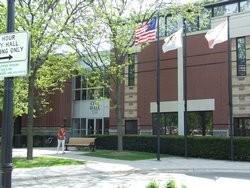for The Elmhurst Independent
As Elmhurst considers an indoor sports facility, a consultant to the City has outlined three types to consider: an ice arena, a gymnasium and a turf facility.
The report, which is on the City’s web site, did not discuss a location.
The estimated total output (direct spending plus indirect/induced spending) for a facility is between approximately $11.9 million and $16.9 million per year. Additionally, this spending is estimated to generate between $5.9 million and $8.2 million annually to boost the local Elmhurst economy. The project will also create between 160 and 225 full and part-time jobs.
Bill Krueger, a consultant with CSI, said conversations with the City and the Elmhurst Park District have indicated that General Obligation (G.O.) Bonds are likely the most viable source of funding.
While a property tax increase is an option, he noted that it is not the only viable mechanism for generating the annual revenue necessary for debt service. Developing a Tax Increment Financing (TIF) district, or extending an existing TIF nearing closure, may provide a significant source of funds.
Another potential source of funding might be an increase in the City’s hotel/motel tax.
With respect to engaging the private sector, Krueger stated that naming rights sales have been used more and more often in amateur sports facility development and/or ongoing operational funding. These partnerships may extend beyond the private sector, Krueger said. Consideration of partnerships with Edward-Elmhurst Healthcare (for wellness aspects), Elmhurst College, IC Catholic Prep or other local education institutions may provide an opportunity to minimize the funding burden on the private sector. He also said they might consider a private equity partner similar to people like Lincoln Frost, for example, who would assume the majority of construction funding and operating risk.
Alderman Scott Levin (5th Ward), chairman of the Development, Planning and Zoning (DPZ) Committee, said the study by CSI was very good and provided an opportunity to consider plans, but said no action would be taken at the October 11th meeting. An indoor sports facility has been discussed off and on periodically for about two years.
At a joint meeting with the DPZ, Vince Spaeth, president of the Elmhurst Park District Board, spoke.
“This is a very rough concept,” he said. “I’m all ears. We are not very far down the road.”
A proposed ice arena would include two sheets (National Hockey League sized 200 ft. by 80 ft.) in a 60,000 square-foot facility. The ice facility is estimated to generate an annual operating loss of roughly $202,000 per year. Krueger stated that this amount is consistent with or better than comparable ice area facilities located throughout the country.
A gymnasium facility could include six hardwood courts and 12 volleyball courts in an approximate 80,000 square-foot facility with about 60,000 square-feet of floor space.
An indoor turf facility would include two full-sized fields (185 ft. by 76 ft. or 180 ft. by 80 ft.) configurable down to smaller fields in a facility of approximately 40,000 square-foot.
In terms of annual operating costs, upon stabilization of operations (assumed to occur by the fourth year) and not including debt service, the gymnasium facility and the indoor turf facility are estimated to generate an operating profit of about $149,000 and $270,000 per year.
Construction costs, including site costs, for an Elmhurst indoor facility are estimated to range between $22.8 million and $32.2 million.
Krueger said his company conducted telephone interviews with more than 50 representatives of local sports and rec organizations and governing bodies with a state, regional and/or national scope.
More than 780 local area residents responded to an online survey. Krueger indicated that rate of response was higher than most.

